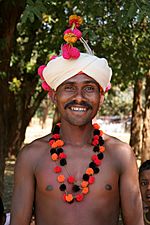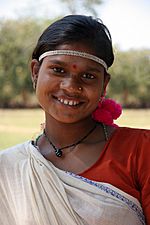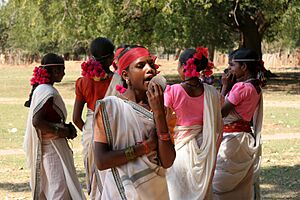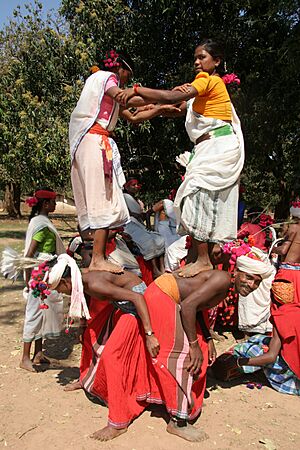Muria people facts for kids
Quick facts for kids Muria Gond |
|
|---|---|
| Location | Bastar, Kondagaon, Narayanpur district, Chhattisgarh, India |
| Language | Gondi, Halbi, Bhattri |
| Religion | Hindu and Nature worship |
| Surnames | Markam (Poyam), Netam, Sorry, Korran, |
The Muria are a group of native people who live in the Bastar district of Chhattisgarh, India. They are part of the larger Gondi people. The Muria are known for working together as a community. They eat many different kinds of food. Special traditional drinks are important at their social gatherings.
Contents
What Does "Muria" Mean?
The name Muria comes from the word mur. This word can mean "root" or "permanent." It might be because the Muria people live in one place. This is different from some other groups, like the Maria, who used to move around a lot.
How Muria Society Works
The Muria people believe that working together is very important. Their society is split into five main groups called phratries. Each phratry is like a large family group.
- the Nagvans (Snake Race)
- the Kacchimvans (Tortoise Race)
- the Bakravans (Goat Race)
- the Baghvans (Tiger Race)
- the Bodminkvans (Fish Race)
Each group has a special animal, called a totem. Muria people are not allowed to eat their totem animal. If one of their totem animals dies, they must show sadness for it.
Muria Clothing Styles
Muria men wear clothes that are similar to those in the Chandrapur District. Muria women often wear simple clothes. Over time, their clothing styles have changed. This happened after they met other tribes.
Where the Muria Live
The Muria people live in the northern part of the Bastar district. This area is north of the Indravati River. It is in the state of Chhattisgarh in central India. They live in two main areas: the Kondagaon District and the Narayanpur District.
Muria Community Economy
The Muria people are quite successful compared to some other native groups. They have traditionally shared their wealth. They believe that showing off too much wealth can cause problems. Having a lot of extra money was seen as something that could disrupt their community.
What the Muria Eat
The Muria people usually grow and find their own food. They get many things from the forest. These include fruits like tendu, chhar, jam, bhelanwa, ber, and mango. They also eat dal, chickpeas, and lentils.
Vegetables like radishes, eggplant, chili, and tomatoes are eaten during special events. Rice is also a common food at these times. Traditional foods are often seen as special treats. The Muria people also enjoy local traditional drinks. These drinks are an important part of their social and religious gatherings.
Muria Beliefs and Religion
The Muria people follow their own traditional religion. They worship nature and the gods of their villages and clans. This is similar to a religion called Sarnaism.





